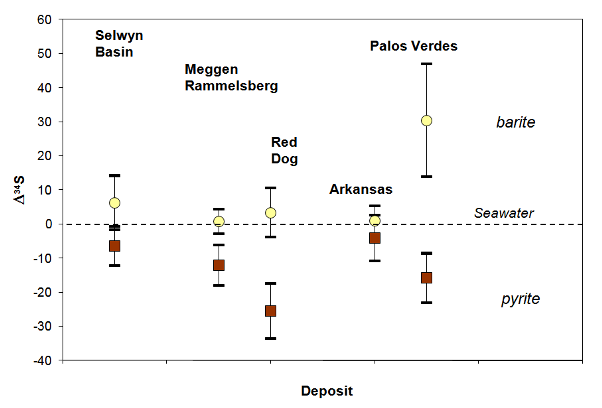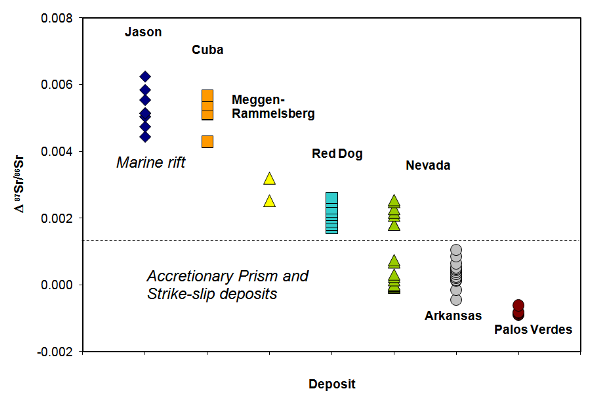Modern barite occurrences
Barium is a relatively abundant element in the Earth’s crust and occurs at concentrations of 200 to 500 ppm in most rocks. However, economically significant barite and lead-zinc-barite deposits are confined to marine strata, owing to the need for a large reservoir of dissolved sulfate (SO42-), which seawater supplies. The barium ion (Ba2+) forms an extremely insoluble sulfate, so that, even at the low barium content of seawater, the oceans are close to saturation with respect to the mineral barite. Therefore it takes only a slight increase in Ba2+ concentration to induce barite precipitation.
Paytan et al. (2002) identified four different modes of formation of barite in modern sediments:
- Authigenic -- crystallizes in the water column, makes small crystals 0.5 to 5 µm.
- Diagenetic, diffusive – upward diffusive flux from anoxic sediments where sulfate reduction has released barium to pore water
- Diagenetic, advective – barium carried by movement of water expelled to the seafloor along faults or in seeps
- Hydrothermal – advection of hot water to the seafloor
Note that the first mechanism constitutes a “from above” source of barium to the seafloor, whereas the other three have a “from below” source.
Significant modern occurrences of barite mineralization |
|||
Location |
Form |
Tectonic setting |
Reference |
Guaymas Basin |
Barite chimneys, barite interbedded with diatomite |
Marine rift on mid-ocean ridge |
Koski et al. 1985 |
Escanaba trough |
Barite chimneys, barite crusts on massive sulfides |
Marine rift on mid-ocean ridge |
Koski et al. 1994 |
Lau Basin |
Barite-sphalerite chimneys |
Marine rift on back-arc ridge |
Fouquet et al. 1993 |
Marianas back-arc |
Barite-sphalerite-galena chimneys |
Marine rift on back-arc ridge |
Kusakabe et al. 1990 |
Gulf of Mexico |
Barite cement and vug fillings of carbonates around methane vents |
Passive continental margin |
Canet et al 2006; Feng and Roberts 2011 |
Peru continental margin |
Massive barite at sediment-water interface |
Accretionary prism of continent-ocean subduction zone |
Aquilina et al. 1997 |
Sea of Okhotsk |
Barite chimneys associated with methane vents |
Transpressional horst in back-arc basin |
Greinert et al. 2002 |
Monterey Canyon |
Barite mounds associated with methane vents |
Transtensional basin |
Naehr et al. 2000 |
San Clemente Basin |
Barite blocks on seafloor |
Transtensional basin |
Torres et al. 2002 |
Southern California offshore |
Barite blocks on seafloor |
Transtensional basin |
Hein et al. 2007 |
The from-above enrichment involves the incorporation of Ba2+ into sinking organic matter, and is marked by a strong correlation between organic carbon (Corg ) and Ba that has led to the wide-spread use of Ba contents of deep-sea sediments as a paleo-productivity indicator. The from-below enrichment involves dissolution of barite at depth in the sediment pile via reduction of the sulfate component to sulfide, followed by the transport of dissolved Ba2+ in sulfate-free water to the sediment-water interface where it reacts with seawater sulfate to redeposit barite. The transport mechanism can simply be diffusion through pore waters, in which case a “barite front” is formed within the shallow part of the sediment. A layer of barite nodules is the common product. For large barite accumulations, fluid movement is required. Advective transport of Ba2+ can be in cold water, producing “cold-seep barites” or in hot water, producing “hydrothermal barite”.
Isotope Chemistry
Barite carries three isotopic signatures: S, O, and Sr. Considerable inquiry has been made into the use of isotope measurements to help distinguish tectonic settings, depositional environments, and mineralization processes (see table of isotope values). For S isotopes, there is considerable overlap among the various categories, indicating that δ34S is controlled by the environment of deposition.

Strontium isotopes, however, show some relationship to tectonic setting. First, the pelagic samples show a very small variance and have average strontium and sulfur values close to seawater. Thus pelagic barite is confirmed as a good recorder of ocean chemistry, if it can be differentiated from the other types. Hydrothermal barites in oceanic rifts have distinctive strontium isotopic values, much less radiogenic than seawater. The Guaymas samples are nearly the same, but show more continental influence, and so should perhaps be considered as belonging to a transitional category. The other groups have a high degree of overlap, and it appears unlikely that strontium can be used alone as an effective discriminator. Calcium isotopes show some promise, but so far the database is too small to make an assessment (see Isotopes in Modern Barite Deposits).

Ore Deposits Home |
Barite references |
Site Map |
|---|